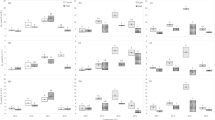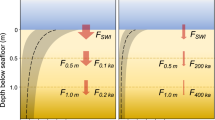Abstract
The flux of nitrogen from land and atmosphere to estuaries and the coastal ocean has increased substantially in recent decades. The observed increase in nitrogen loading is caused by population growth, urbanization, expanding water and sewer infrastructure, fossil fuel combustion and synthetic fertilizer consumption1,2. Most of the nitrogen is removed by denitrification in the sediments of estuaries and the continental shelf, leading to a reduction in both cultural eutrophication and nitrogen pollution of the open ocean3,4. Nitrogen fixation, however, is thought to be a negligible process in sub-tidal heterotrophic marine systems5. Here we report sediment core data from Narragansett Bay, USA, which demonstrate that heterotrophic marine sediments can switch from being a net sink to being a net source of nitrogen. Mesocosm and core incubation experiments, together with a historic data set of mean annual chlorophyll production6,7, support the idea that a climate-induced decrease in primary production has led to a decrease in organic matter deposition to the benthos and the observed reversal of the net sediment nitrogen flux. Our results suggest that some estuaries may no longer remove nitrogen from the water column. Instead, nitrogen could be exported to the continental shelf and the open ocean and could shift the effect of anthropogenic nitrogen loading beyond the immediate coastal zone.
This is a preview of subscription content, access via your institution
Access options
Subscribe to this journal
Receive 51 print issues and online access
$199.00 per year
only $3.90 per issue
Buy this article
- Purchase on Springer Link
- Instant access to full article PDF
Prices may be subject to local taxes which are calculated during checkout



Similar content being viewed by others
References
Howarth, R. W. & Marino, R. Nitrogen as the limiting nutrient for eutrophication in coastal marine ecosystems: Evolving views for over three decades. Limnol. Oceanogr. 51, 364–376 (2006)
Galloway, J. N. & Cowling, E. B. Nitrogen and the world: 200 years of change. Ambio 31, 64–71 (2002)
Nixon, S. W. et al. The fate of nitrogen and phosphorus at the land-sea margin of the North Atlantic Ocean. Biogeochemistry 35, 141–180 (1996)
Seitzinger, S. P. & Giblin, A. E. Estimating denitrification in north Atlantic continental shelf sediments. Biogeochemistry 35, 235–260 (1996)
Howarth, R. W., Marino, R., Lane, J. & Cole, J. J. Nitrogen fixation in freshwater, estuarine, and marine ecosystems. 1. Rates and importance. Limnol. Oceanogr. 33, 669–687 (1988a)
Li, Y. & Smayda, T. Temporal variability of chlorophyll in Narragansett Bay 1973–1990. ICES J. Mar. Sci. 55, 661–667 (1998)
Fulweiler, R. W. & Nixon, S. W. Responses of benthic-pelagic coupling to climate change in a temperate estuary. Hydrobiologia (in the press)
Walther, G. R. et al. Ecological response to recent climate change. Nature 416, 389–395 (2002)
Farnsworth, E. J., Núñez-Farfán, S. A., Careaga, S. A. & Bazzaz, F. A. Phenology and growth of three temperate forest life forms in response to artificial soil warming. J. Ecol. 83, 967–977 (1995)
Townsend, D. W. & Cammen, L. M. Potential importance of the timing of spring plankton blooms to benthic-pelagic coupling and recruitment of juvenile demersal fishes. Biol. Oceanogr. 5, 215–229 (1988)
Edwards, M. & Richardson, A. J. Impact of climate change in marine pelagic phenology and trophic mismatch. Nature 430, 881–884 (2004)
Kemp, W. M. et al. Eutrophication of Chesapeake Bay: historical trends and ecological interactions. Mar. Ecol. Prog. Ser. 303, 1–29 (2005)
Nixon, S. W., Kelly, J. R., Furnas, B. N., Oviatt, C. A. & Hale, S. S. in Marine Benthic Dynamics (eds Tenore, K. R. & Coull, B. S.) 219–242 (Univ. of South Carolina Press, Columbia, 1980)
Nixon, S. W., Granger, S., Buckley, B. A., Lamont, M. & Rowell, B. A one hundred and seventeen year coastal water temperature record from Woods Hole, Massachusetts. Estuaries 27, 397–404 (2004)
Oviatt, C. A., Keller, A. & Reed, L. Annual primary production in Narragansett Bay with no bay-wide winter-spring phytoplankton bloom. Estuar. Coast. Shelf Sci. 54, 1013–1026 (2002)
Borkman, G. D. Analysis and Simulation of Skeletonema costatum (grev.) Cleve Annual Abundance Patterns in Lower Narragansett Bay 1959–1996 PhD dissertation, Univ. Rhode Island. (2002)
Nixon, S. W. et al. in Ecosystem-Based Estuary Management: A Case Study of Narragansett Bay (eds Desbonnet, A. Colt, A. B. & Costa-Pierce, B. A.) (Springer, in the press)
Borkman, G. D. & Smayda, T. J. Long-term trends in water clarity revealed by secchi-disk measurements in lower Narragansett Bay. ICES J. Mar. Sci. 55, 668–679 (1998)
Brush, M. J., Brawley, J. W., Nixon, S. W. & Kremer, J. N. Modeling phytoplankton production: problems with the Eppley curve and an empirical alternative. Mar. Ecol. Prog. Ser. 238, 31–45 (2002)
Nixon, S. W., Granger, S. L. & Nowicki, B. L. An assessment of the annual mass balance of carbon, nitrogen, and phosphorus in Narragansett Bay. Biogeochemistry 31, 15–61 (1995)
Sisler, F. D. &. ZoBell, C. E. Nitrogen fixation by sulfate reducing bacteria indicated by nitrogen/argon ratios. Science 113, 511–512 (1951)
Kana, T. M. et al. Membrane inlet mass-spectrometer for rapid high-precision determination of N2, O2, and Ar in environmental water samples. Anal. Chem. 66, 4166–4170 (1994)
Galloway, J. N. et al. Nitrogen cycles: past, present, and future. Biogeochemistry 70, 153–226 (2004)
Keller, A. A., Oviatt, C. A., Walker, H. A. & Hawk, J. D. Predicted impacts of elevated temperature on the magnitude of the winter-spring phytoplankton bloom in temperate coastal waters: A mesocosm study. Limnol. Oceanogr. 44, 344–356 (1999)
Furnas, M. J., Hitchcock, G. L. & Smayda, T. J. in Estuarine Processes Vol. 1 Uses, Stresses and Adaptation to the Estuary (ed. Wiley, M.) 118–133 (Academic Press, New York, 1976)
Seitzinger, S. P. & Garber, J. H. Nitrogen fixation and 15N2 calibration of the acetylene reduction assay in coastal marine sediments. Mar. Ecol. Prog. Ser. 37, 65–76 (1987)
Gardner, W. S. et al. Nitrogen fixation and dissimilatory nitrate reduction to ammonium (DNRA) support nitrogen dynamics in Texas estuaries. Limnol. Oceanogr. 51, 558–568 (2006)
Oviatt, C. A. et al. An ecosystem level experiment on nutrient limitation in temperate coastal marine environments. Mar. Ecol. Prog. Ser. 116, 171–179 (1995)
Seitzinger, S. P. The Importance of Denitrification and Nitrous Oxide Production in the Nitrogen Dynamics and Ecology of Narragansett Bay, Rhode Island PhD dissertation, Univ. Rhode Island. (1982)
Nowicki, B. L. The Fate of Nutrient Inputs to Estuaries: Evidence from Estuarine Mesocosms PhD dissertation, Univ. Rhode Island. (1991)
Pinckney, J. L. et al. Application of photopigment biomarkers for quantifying microalgal community composition and in situ growth rates Org. Geochem. 32, 585–595 (2001)
Acknowledgements
This material is based on work supported by the National Science Foundation to the Rhode Island EPSCoR programme, as well as the Rhode Island Sea Grant College Program (NOAA), the Rhode Island Coastal Resource Management Council, and the Switzer Foundation. We acknowledge and appreciate the assistance of A. Giblin, J. Tucker and K. Koop-Jacobsen of the Marine Biological Laboratory and J. Cornwell, M. Owens, T. Kana, and J. Seabrease of the University of Maryland. We also thank H. Paerl and K. Rossignol of the University of North Carolina. In addition we thank M. Hayn at Cornell University and L. Cole at the University of Virginia. This manuscript was improved with comments from A. Giblin, M. E. Q. Pilson and B. Jenkins. For field assistance we thank P. DiMilla, K. Hanks, K. Henry, M. Horn, J. Krumholz, C. Mueller, A. Oczkowski, A. Pimenta, M. Traber, and N. Hovey. We thank L. Harris for assistance with the primary production model.
Author Contributions R.W.F. was responsible for sediment collection as well as sample and data analysis for net N2 measurements. R.W.F. and S.W.N. co-wrote this manuscript. B.A.B. was responsible for statistical analysis. B.A.B and S.L.G. supervised the large-scale mesocosm experiment.
Author information
Authors and Affiliations
Corresponding author
Ethics declarations
Competing interests
Reprints and permissions information is available at www.nature.com/reprints. The authors declare no competing financial interests.
Supplementary information
Supplementary Information
This file contains Supplementary Discussion, Supplementary Figures S1-S2 with Legends and additional references. (PDF 129 kb)
Rights and permissions
About this article
Cite this article
Fulweiler, R., Nixon, S., Buckley, B. et al. Reversal of the net dinitrogen gas flux in coastal marine sediments. Nature 448, 180–182 (2007). https://doi.org/10.1038/nature05963
Received:
Accepted:
Issue Date:
DOI: https://doi.org/10.1038/nature05963
This article is cited by
-
Hurricane Effects on Benthic Nitrogen Cycling in an Emerging Coastal Deltaic Floodplain Within the Mississippi River Delta Plain
Estuaries and Coasts (2024)
-
Nitrogen fixation and diazotroph diversity in groundwater systems
The ISME Journal (2023)
-
Evaluating Connections Between Nitrogen Cycling and the Macrofauna in Native Oyster Beds in a New England Estuary
Estuaries and Coasts (2022)
-
Denitrification in intertidal sediments of a tropical estuary subject to increasing development pressures
Aquatic Sciences (2022)
-
Spatial and temporal patterns of benthic nutrient cycling define the extensive role of internal loading in an agriculturally influenced oxbow lake
Biogeochemistry (2022)
Comments
By submitting a comment you agree to abide by our Terms and Community Guidelines. If you find something abusive or that does not comply with our terms or guidelines please flag it as inappropriate.



